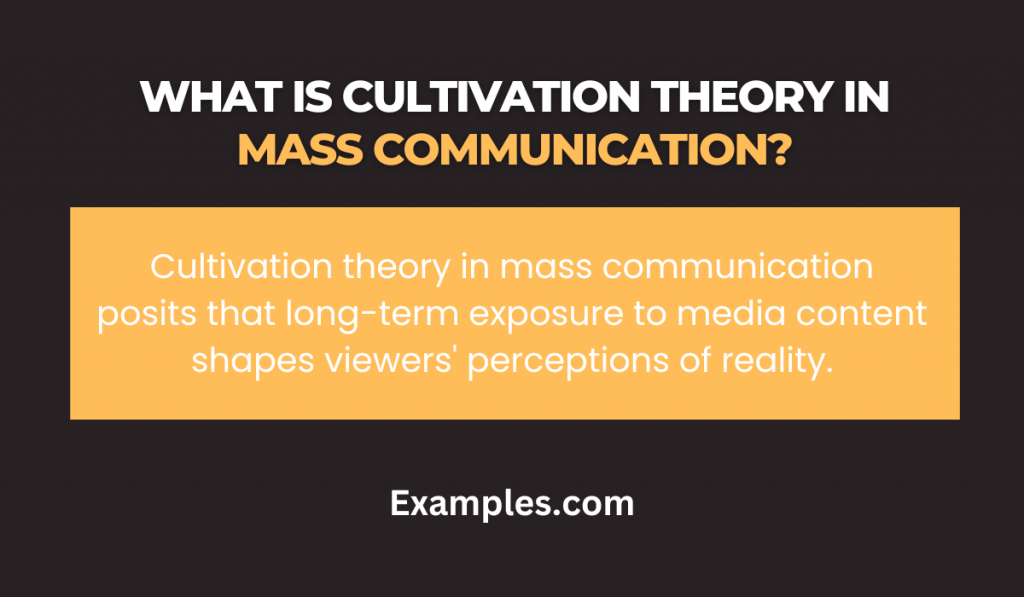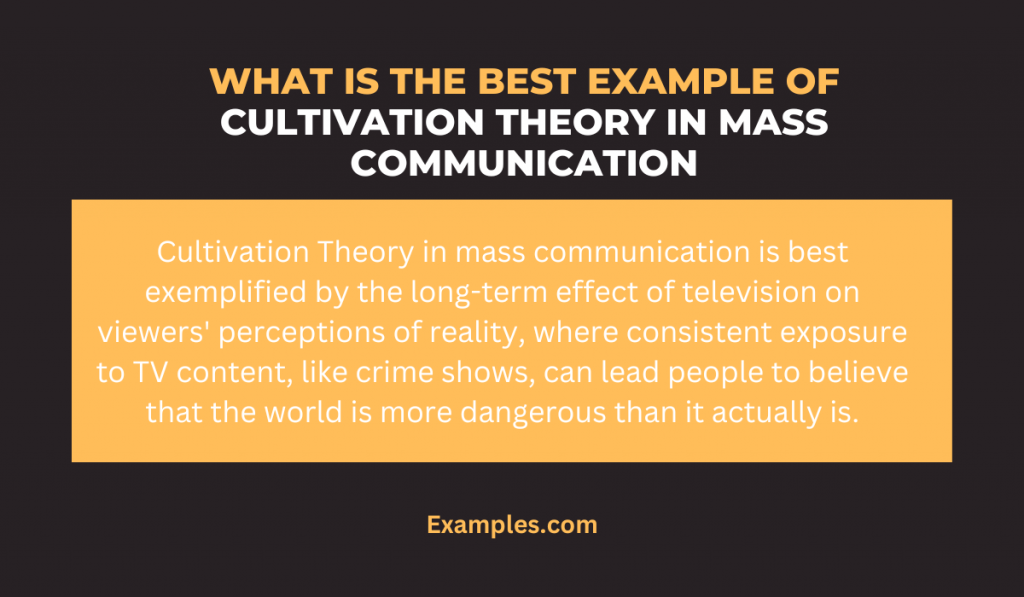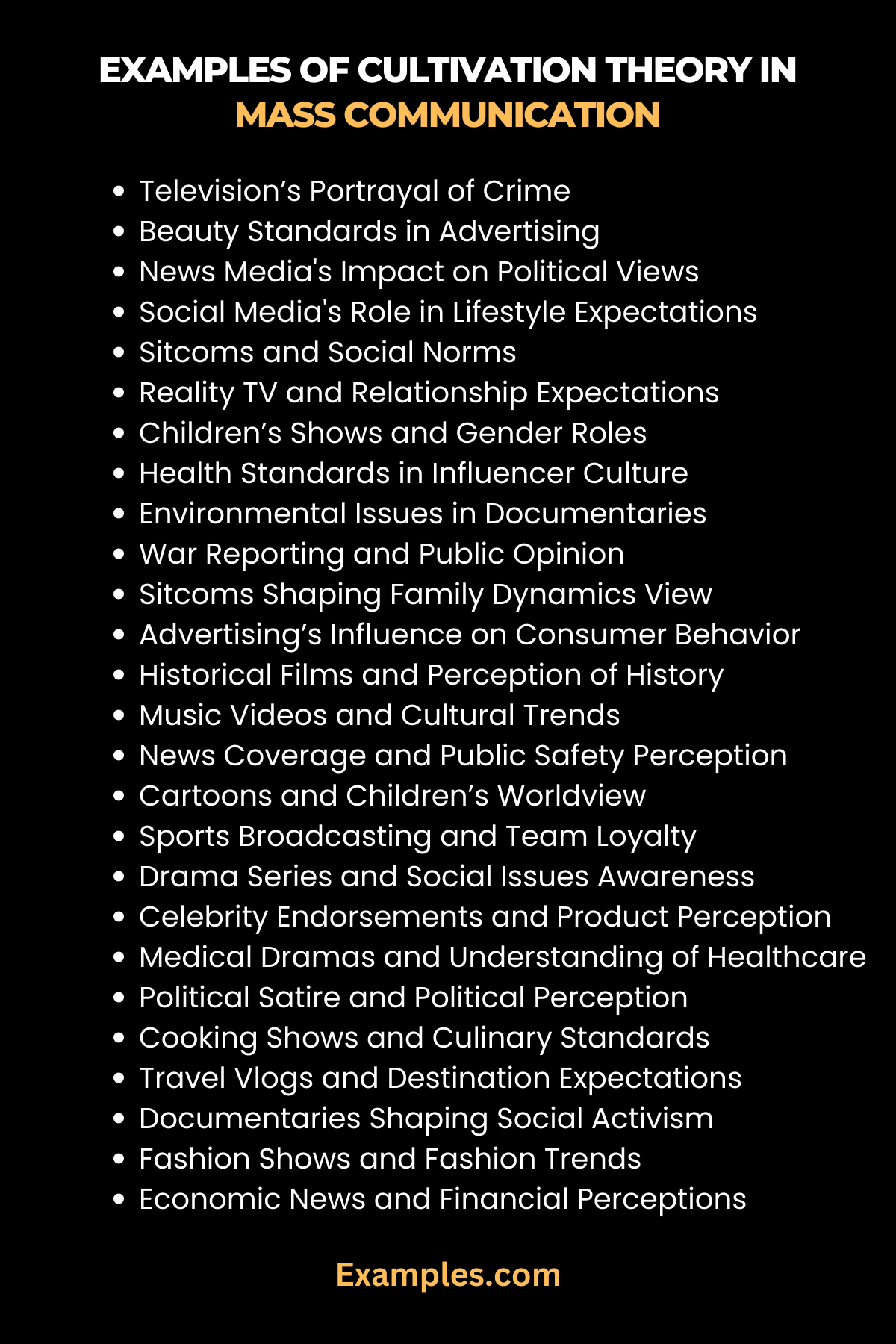29+ Cultivation Theory in Mass Communication Examples
Delve into the profound impact of Cultivation Theory in Mass Communication, a cornerstone concept shaping our understanding of media’s role in society. This comprehensive guide, enriched with practical Mass Communication Examples, unravels how repeated media exposure influences perceptions. It’s a vital exploration for students and professionals in fields like Television Mass Communication and social media, offering insights into the subtle yet powerful ways media molds public consciousness.
What is Cultivation Theory in Mass Communication?
Cultivation Theory, a significant concept within the realm of mass communication, delves into the long-term effects of television. The core of this theory lies in understanding how television content can shape viewers’ perceptions of reality. This theory, a part of the broader spectrum of Mass Communication Theories, suggests that heavy television viewers tend to perceive the real world in ways that are consistent with the portrayals they see on television.
Origin and Development of Cultivation Theory
Cultivation Theory was introduced in the 1960s by George Gerbner, a pioneering researcher in Mass Communication. It emerged from a context where television was becoming a dominant medium in households. Gerbner’s research initially focused on the symbolic content of television, particularly the depiction of violence and how it affected viewers’ perception of social reality.
Key Concepts of Cultivation Theory
The theory is built on two primary concepts: ‘Mainstreaming’ and ‘Resonance’. Mainstreaming refers to the phenomenon where heavy viewers of television develop a homogenized view of reality based on what they consistently see on TV. Resonance occurs when the viewer’s real-life environment strongly resembles the world of TV shows, thereby amplifying the cultivation effect.
Applications of Cultivation Theory in Modern Media
In the contemporary digital age, the scope of Cultivation Theory has expanded beyond television to include various forms of media like Social media Mass Communication and online platforms. The theory helps in analyzing how consistent messaging across these mediums can shape public perception on issues like health, politics, and social norms.
Criticisms and Limitations
While influential, Cultivation Theory has its critics. Some argue that it underestimates viewer agency and the diversity of television content. Additionally, the theory faces challenges in adapting to the complexities of the current media landscape, which includes a multitude of channels and platforms, each with its distinct content and audience.

History
The Cultivation Theory, a significant concept in Mass Communication Theories, was first introduced in the 1960s by George Gerbner, a prominent media researcher. This theory focuses on the long-term effects of television on audiences, particularly how television shapes viewers’ perceptions of reality. The essence of the theory lies in the argument that consistent and prolonged exposure to television content can lead to a distorted view of the world, more aligned with the television world than the actual one.
Gerbner’s research initially centered around the effects of television on American viewers, especially concerning violence and the fear of being victimized. Over time, the theory expanded to include broader aspects like gender roles, racial stereotypes, and social norms. The cultivation effect implies that heavy TV viewers are more likely to perceive the real world in ways that reflect the most common and recurring messages of the television world, a phenomenon Gerbner termed ‘mean world syndrome’.
As media landscapes evolved, the theory’s application extended beyond television to include other forms of media, such as Social media Mass Communication and digital content. The foundational concepts of the Cultivation Theory remain influential in understanding how media can shape societal beliefs and attitudes.
What is the Best Example of Cultivation Theory in Mass Communication
One of the best examples of Cultivation Theory in action can be seen in the portrayal of crime and violence on television. Regular exposure to TV shows that depict a high level of violence can lead to a perception that the real world is more dangerous than it actually is. This is the ‘mean world syndrome’ effect, where heavy viewers of crime dramas, for instance, might overestimate the frequency of criminal activities in their daily environment.
Another pertinent example is the representation of social and demographic groups on television. For instance, if certain ethnic groups are consistently portrayed in negative or stereotypical roles, heavy viewers might develop skewed perceptions of these groups in real life. This effect of Cultivation Theory highlights how media can reinforce, perpetuate, or even create stereotypes and biases in society.
In the digital age, this theory also finds relevance in the context of internet and social media usage. Platforms like Facebook, Twitter, and Instagram can also cultivate perceptions about social norms, beauty standards, and lifestyle expectations. The pervasive nature of Mass Communication in a Digital Age reinforces the idea that media consumption, regardless of the platform, plays a crucial role in shaping our perception of reality.
Understanding Cultivation Theory helps in comprehending the subtle yet profound impact mass media can have on societal attitudes and values, an aspect crucial for students, researchers, and professionals in the field of mass communication

30 Examples of Cultivation Theory in Mass Communication
Cultivation Theory in mass communication emphasizes how media exposure shapes audience perceptions, particularly regarding social realities. This theory, integral to understanding Mass Communication Characteristics and Mass Communication in Real Life, suggests that prolonged media exposure can align viewers’ beliefs with those presented in the media. Here are 30 unique examples illustrating Cultivation Theory:

- Television’s Portrayal of Crime: “Shows like ‘Crime City’ often depict a world more dangerous than reality, potentially leading viewers to overestimate crime rates in their community.”
- Beauty Standards in Advertising: “Advertisements often showcase unrealistic beauty standards, which can cultivate a perception that such standards are normal and attainable.”
- News Media’s Impact on Political Views: “Regular viewing of a particular news channel might shape one’s political outlook, aligning it more closely with the channel’s bias.”
- Social Media’s Role in Lifestyle Expectations: “Frequent exposure to luxury lifestyles on social media can alter one’s perception of a ‘normal’ lifestyle.”
- Sitcoms and Social Norms: “Sitcoms often portray exaggerated characters and situations, potentially affecting viewers’ understanding of social interactions and norms.”
- Reality TV and Relationship Expectations: “Shows like ‘Love Island’ might influence viewers to have unrealistic expectations about relationships and romance.”
- Children’s Shows and Gender Roles: “Children’s programming often reinforces traditional gender roles, influencing young viewers’ understanding of gender.”
- Health Standards in Influencer Culture: “Fitness influencers often cultivate a perception that extreme fitness is commonplace and desirable.”
- Environmental Issues in Documentaries: “Documentaries about climate change can shape viewers’ perceptions and concern regarding environmental issues.”
- War Reporting and Public Opinion: “Continuous war coverage can influence public opinion about foreign policy and conflict.”
- Sitcoms Shaping Family Dynamics View: “Family-oriented sitcoms might shape viewers’ expectations about family life and relationships.”
- Advertising’s Influence on Consumer Behavior: “Advertisements not only sell products but also lifestyles, influencing consumer behavior and aspirations.”
- Historical Films and Perception of History: “Films set in historical periods can shape viewers’ perceptions of those times, regardless of accuracy.”
- Music Videos and Cultural Trends: “Music videos often showcase and amplify cultural trends, influencing viewers’ tastes and behaviors.”
- News Coverage and Public Safety Perception: “Extensive coverage of violent incidents by news media can lead to an exaggerated perception of danger.”
- Cartoons and Children’s Worldview: “Cartoons with fantastical elements might shape children’s understanding of the world and physics.”
- Sports Broadcasting and Team Loyalty: “Regular watching of a sports team can cultivate strong loyalty and identification with the team.”
- Drama Series and Social Issues Awareness: “Series tackling social issues can raise awareness and shape viewers’ opinions on these topics.”
- Celebrity Endorsements and Product Perception: “Celebrity endorsements in advertising can influence viewers’ perceptions of a product’s value and appeal.”
- Medical Dramas and Understanding of Healthcare: “Shows like ‘MediLife’ can shape viewers’ expectations and understanding of healthcare and medical procedures.”
- Political Satire and Political Perception: “Satirical shows about politics can influence viewers’ perceptions of political figures and institutions.”
- Cooking Shows and Culinary Standards: “Cooking shows can shape viewers’ understanding of culinary skills and food standards.”
- Travel Vlogs and Destination Expectations: “Travel vlogs might cultivate unrealistic expectations about travel destinations and experiences.”
- Documentaries Shaping Social Activism: “Documentaries on social issues can motivate viewers to engage in social activism.”
- Fashion Shows and Fashion Trends: “Fashion shows broadcasted on TV can influence public perception of fashion trends and standards.”
- Economic News and Financial Perceptions: “Regular consumption of economic news can shape one’s perception of the economy and personal finance management.”
- Tech Reviews and Consumer Expectations: “Tech review shows can influence consumer expectations and demand for technology products.”
- Game Shows and Perceptions of Luck: “Game shows might influence viewers’ understanding of luck and probability.”
- Educational Programs and Knowledge Acquisition: “Educational TV programs can positively shape viewers’ knowledge and understanding of various subjects.”
- Soap Operas and Social Drama Perception: “Regular watching of soap operas might lead to an exaggerated perception of social drama and conflict in real life.”
Role of Cultivation Theory in Mass Communication
The role of Cultivation Theory in the realm of mass communication is pivotal. It provides a framework for understanding how media, especially television, shapes viewers’ perceptions of reality. This theory, developed by George Gerbner in the 1960s, posits that heavy television viewers tend to perceive the real world in ways that reflect the most recurrent and repetitive messages and images portrayed on television. Here’s how it plays a crucial role:
- Perception of Reality: Cultivation Theory suggests that prolonged exposure to media content, particularly TV, shapes viewers’ concepts of social reality. It blurs the line between reality and the media’s portrayal of it.
- Mainstreaming and Resonance: The theory introduces concepts like ‘mainstreaming’ (aligning disparate views to the ‘mainstream’ portrayed in media) and ‘resonance’ (where viewers’ real-life experiences align with media representations).
- Influencing Public Opinion: It’s instrumental in understanding how media can mold public opinion, particularly in areas like politics, societal norms, and values.
Importance of Cultivation Theory in Mass Communication
Understanding the importance of Cultivation Theory is vital in comprehending the impact of mass media on society. Its significance lies in several key areas:
- Media Literacy: This theory underscores the importance of media literacy, enabling individuals to critically analyze media content and its potential influence.
- Media Policy and Regulation: Insights from Cultivation Theory can inform media policy and regulation, ensuring a balanced and ethical media landscape.
- Research and Academia: It provides a robust theoretical base for academic research in media studies, sociology, and psychology, helping to unpack the complex relationship between media and society.
How to Use Cultivation Theory in Mass Communication
Utilizing Cultivation Theory in mass communication involves several practical applications:
- Content Creation and Broadcasting: Media professionals can use insights from the theory to produce content that is mindful of its potential impact on audiences’ perception of reality.
- Media Education: It can be used in educational settings to teach students about the effects of media on societal perceptions and attitudes.
- Public Awareness Campaigns: Cultivation Theory can guide the development of campaigns that aim to alter public perceptions on critical issues, using the media as a tool for societal change.
By integrating Mass Communication Examples in a Digital Age and considering the Main Functions of Mass Communication, this comprehensive understanding of Cultivation Theory offers a deep insight into the profound influence of media on societal perceptions and attitudes.
Understanding the Two-Step Flow Theory highlights the intricate nature of Mass Communication in Real Life. It emphasizes how information is processed and shared, playing a pivotal role in shaping public opinion. This theory underscores the importance of key influencers in mass communication, reflecting on its dynamic and influential nature in today’s interconnected world.



